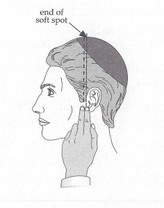|
In short $12
It may seem obvious to state, but not all Sofrim provide the same quality of work and give the Mezuzahs the same level of attentions. Some do a quicker job just the bare minimum. while others hold the Mezuzahs to a higher standard to ensure its Kosher status. For this reason alone it is important to realize that when looking for a Sofer to check your Mezuzahs you must shop for their reputation of quality work not their price. Being that a Sofer is being paid for their time. The cheaper the checking is more often then not an indication of a lower level of inspection, as less time is spent on each Mezuzah or someone less qualified is doing the checking, hence less cost. I have seen unfortunately in many a Sofer Stam employing young students who are only just beginning to learn Safrus to do the checking even before they have received their Kabolah. or just eyeballing the Mezuzahs in short minute or two. (a physical impossibility) to ensure its Kosher status. At the Sofer Center we spend 12-15 minutes per Mezuzah when checking, (not including time for rolling and putting back in the case.) We are not ok with your Mezuzahs just barley "passing" examination and we are highly qualified and certified. When we check we are looking for;
In most cases we can accommodate same day checking but depending on our availability it is best to call and schedule ahead of time.
4 Comments
Yes it does, however as far as a Brachah/Blessing is concerned it depends on the location of the garage. If it is adjoining or part of the house, such that one can exit the car and walk through a door into the house without leaving the garage all agree a Brachah/Blessing is recited. If however the garage is not adjoining or part of the house nor encircled by a gate that encompasses both it and the house it is a matter of dispute and therefore a Brachah should not be recited.
The reason is to demonstrate our love for this Mitzvah.
There is a source to this custom in the Talmud regarding the conversion of the Roman Caesar’s men (Avodah Zarah 11b). Onkelos the son of Klonimus converted to Judaism. The Caesar, his uncle sent a legion of Roman soldiers to retrieve him. However, he enticed them to Judaism by quoting verses, and they converted to Judaism.The Caesar sent a new legion but this time he instructed them not to enter into conversation with his nephew. As they dragged him from his home, Onkelos saw the Mezuzah affixed to his doorpost. He placed his hand upon it to kiss it and asked them, “Do you know what this is?” The soldiers could not contain their curiosity and answered, “You tell us” Onkelos explained to them, “It is the custom of the world that the king sits in the inside of the palace, and the guards protect him from the outside. However, with G‑d, His servants are inside their homes and He protects them from the outside, as the verse says (Psalms 121:8), “G‑d will protect your departure and your arrival from now and forever. They were inspired and they too converted to Judaism. After that, the Caesar ceased sending soldiers to bring him back. A right-handed person should use his right hand and a left-handed person should use their left hand. It is permitted to kiss the Mezuzah even before one has washed his or her hands in the Morning since the Mezuzah is covered in a case. If a Mezuzah has fallen down on to the ground and it is still in its case one should give charity. If it is not in its case (if the case breaks from the fall or it falls while it is being inserted into its case) it is questionable whether one is required to fast as in the case of Tefillin. In this case, one should as least give charity.
It is written in Seforim that if a Mezuzah falls down it is customary to have it checked before it is reaffixed. If one does not have plans to get the Mezuzah checked, it must be reaffixed immediately (even before putting on Tefillin or davening) with a Brachah if its a location that requires a Brachah. If however, it cannot be reaffixed immediately, for example if it falls off on Shabbos/Shabbat, you may continue to use the room. The Mezuzah should be picked up in an irregular manner, i.e. with a spoon and put aside in order to be put up right after Shabbos. Practically speaking, before you put it back up you should check that it was attached properly, such as with screws, nails or double-sided mounting tape. If it wasn’t make sure it is re-affixed properly. 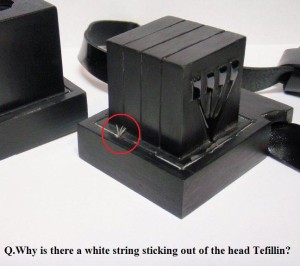 Actually, it is not any ordinary string; it is hair from a kosher animal. It is a Halachah transmitted to Moshe at Sinai, that all of the Parshios (Tefillin text) need to be wrapped with hair of a kosher animal. It is customary to use the hair from the tail of a calf, and the reason it sticks out of the head Tefillin is so we will constantly see it and be reminded of the Cheit Haeigel (the sin of the golden calf). This will keep us humble and prevent us from coming to sin. The general custom is not to be too particular about how many hairs stick out of the head Tefillin, though it is preferred to have at least two. If the hairs were never pulled out or they were but slipped back inside, the Tefillin are still kosher bedieved (when you have no other Tefillin and have no local Sofer to bring it and get it fixed). Therefore, it would be important to take care of it as soon as possible. 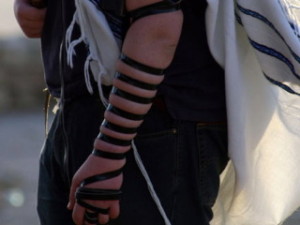 No, there may be no separation between the body and the Tefillin batim/boxes or the Retzuah/Teffilin straps that encircles the head or the upper arm which hods the Hand Tefillin box in place. Preferably there should not be any separation between the body and the rest of the Tefillin strap as well. This includes, shirt sleeves, watches or a Kipa, if one wears a toupee it must be removed before putting on Tefillin. If medically necessary it is permitted to wear a medicinal patch or bandage under the Rezuah Shel Yad/Hand Tefillin Strap. If medically necessary it is permitted to wear a medicinal patch or bandage under the Rezuah Shel Yad/Hand Tefillin Strap. Someone who, G-d forbid, broke their arm continues to place Tefillin on the broken arm (the Halachic authorities only have a doubt if the arm is permanently paralyzed). If the cast is only on the arm and not on the bicep, then one makes a Bracha/Blessing and puts the Tefillin on the bicep and wraps the strap over the cast. If the cast covers the bicep the Tefillin is placed on the bicep (and wrapped around the arm) but without a Brachah. Even in such a case a Brachah must be made on the head Tefillin. There should be no writing on the underside of the Straps. Some Rabbis consider long bangs to be a separation between the Tefillin and the head. A person should also take in to consideration that it is hard to keep the Tefillin in the correct place if it is resting on long thick locks of hair. The underside of the Retzuos must rest against the arm and the head. No part of the Retzuah/Tefillin Strap may be flipped over that the underside is visible. 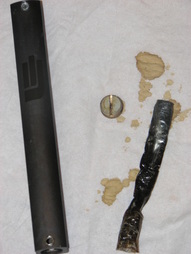 Water-logged Mezuzah Water-logged Mezuzah Note: The word Mezuzah always refers to the scroll, and the case or cover is always referred to as such. Even if your Mezuzah is written properly and according to Halacha, being that it is a very delicate item it needs to be treated gently and cared for properly. It may seem obvious, but many people are unaware of the issues at hand. Every Mezuzah should be wrapped in a protective wrapping before it is placed in a case. Wax paper, parchment paper, Saran Wrap holds moisture in, which may cause damage to the Mezuzah as well it melts in very hot temperatures onto and ruin the Mezuzah. A Mezuzah case that does not necessitate the Mezuzah to be rolled tightly is best. This will place less stress on the letters and help prevent the ink from cracking. Also, when there is sufficient space inside there will be less chance of the Mezuzah tearing or crumpling when it is put in and taken out. Never force a Mezuzah into its case if it does not get ruined going in there is a big chance it will be stuck in and get ruined coming out. Outdoor Mezuzos A Mezuzah affixed outdoors must be placed in a sealed plastic Water proof Mezuzah cover or a specially treated wood case which opens only from the bottom with a plug or screw. A water proof cover is a solid piece of plastic with only one opening on the bottom and it is sealed airtight with a rubber cork. This will help prevent rain from seeping in. Care should be taken to prevent water from being directed toward the case from the bottom, for example with a sprinkler. If a Mezuzah will be in direct sunlight, use a solid white or silver-colored case in order to reflect the light. Clear plastic cases are not recommended for use in direct sunlight, as the Mezuzah may get burn spots or dry out and crack[ Dark-colored cases will get very hot and may damage the Mezuzah. As well it is important to avoid metal covers, the reason for this is two fold 1) The Das Kedoshim writes as follows; The reward for fulfilling the Mitzvah of Mezuzah is long life as the Posuk says “Leman Yirbu Yimeichem” and weapons of war are made from Barzel – Metal therefore it’s not proper to put a Mezuzah in a material that cuts life short. 2) Metal tends to absorb the temperature much more than plastic, in the winter it becomes ice-cold and in the summer it gets scolding hot,which is very damaging for a Mezuzah. (think about it would you touch a metal railing during the winter months without gloves? or a metal railing in the heat of a summer day? I think not! ) Convenience in Affixing Mezuzos Fragile Mezuzah cases, such as those made from silver, glass, ceramics and Polymer clay must be affixed with extreme care. If they are not affixed gently they may crack or break. Be sure not to tighten the screws or nails tightly as the pressure can also cause damage. It is advisable to use screws, rather than nails, to affix a Mezuzah because it will be easier to take down later and there is less risk of causing damage to the case and the door frame when removing nails. Double-sided foam tape may be used to affix a Mezuzah case as long as the case does not have a removable back. This is an excellent option if you do not want to make holes in the door frame or will have difficulty making holes. Cellophane or masking tape should preferably not be used if the case will not be firmly affixed. Many people dread removing and re-affixing their Mezuzos when it is time to have them checked. To avoid this feeling it is suggested to use cases which unscrew or unplug from the top or bottom. With these cases one only needs to remove the plug and possibly one screw to remove and reinsert the Mezuzah. If a Mezuzah is stuck inside its case, carefully bang the case against another object to loosen it. Alternatively, you can remove the Mezuzah by grasping the very bottom of it with a blunt tweezers, taking care not to damage the lettering. In order to be certain that the Sha-dai remains facing forward inside an opaque case, the Mezuzah should be rolled loosely enough so that it cannot rotate but tightly enough for it to be easily removed. Alternatively, it can be taped into place. If you use a clear case or one with a window for the Sha-dai, you will always be able to see if it is facing forward. Some Mezuzah cases are made of a clear glass or plastic tube resting in a wood or metal base. The tube of this type of case often turns, causing the Sha-dai to shift this is a proplem Simply twist it back into place as necessary and tape the back of the tume to post When cleaning a Mezuzah’s outer case it can be lightly dusted. But never use liquid cleaners because they may seep within the case and damage the parchment scroll. The Kitzur Shulchan Aruch states that Mezuzos and Tefillin should optimally be checked on a yearly basis. If that is not possible then Mezuzos must be checked at least every three and a half years. By checking your Meuzuzos regularly you will prevent serious problems from occurring as well as a potential big expense of having to replace your Mezuzos. If the letters start to grey or if the letters and crowns begin to form a small crack and break this will cause the Mezuzah to become not Kosher, if caught in time it can be fixed, however if it goes years without attention chances are it will be too late the breaks will be to big to be able to fixed and it will have to be replaced. As well unfortunately there are Mezuzos that were Not Kosher from the get go, and the more times they are checked the more chances you have to finding the problems. 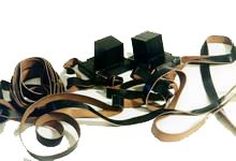 To prevent your Tefillin from getting lost, mark your name, address, and telephone number on or inside your Tefillin bag and on the individual Tefillin cases. (Do not put labels over the air vents of the Tefillin cases.) Take note of identifying marks on your batim, leather housing and Retzuos / straps. ( we give labels out free of charge if you need stop by the office.) In order not to lose your Tallis and Tefillin when traveling, be sure to keep them in your suitcase or carry-on bag. Don't carry them separately. When taking a bus keep your Tallis and Tefillin bag on your lap or inside a bag or briefcase with your other things. If one is traveling alone, he may take his Tefillin into the washroom, as long as they are inside a second bag. Do not leave your Tefillin sitting out in Shul or in school. If there is no locked cabinet or room available, put them away in a closed cabinet or out of sight. Similarly, if you absolutely must leave your Tefillin in the car, they should be kept out of sight. An attractive Tefillin bag may entice someone to break in and steal it. Students and campers: Do not put your Tefillin bag on top of your laundry bag when returning home! You will not be happy if they accidentally go into the washing machine. Protecting the Bayis Shel Rosh The Tallis should not be covering over the Shel Rosh. In additoin to the Halacha that it needs to be uncovered in reference to the verse וראו כל עמי הארץ כי שם ה נקרא אליך ויראו ממך (and all the nations of the earth will see that the name of G-D is called upon you and the nations of the world will fear you") Chazal say this refers to the Tefillin Shel Rosh "Shem Hashem Nikrah" start with the letters שין They will see the ש and fear you Chazal say this is the ש of the Shel Rosh. In addition it will gradually cause the paint to wear off the Bayis's (leather housing, singular) corners and the edges and cause them to lose their sharpness. A tallis with a silver atarah (adornment) is heavier than a regular tallis and will therefore cause the paint on the corners to wear off more quickly. If you regularly wear your tallis over your shel rosh, you must keep a close eye on its corners and edges. A black, plastic shel-yad cover can be cut out in order for the shins to be visible and placed on the shel rosh to protect it. Those who wear a hat during Shachris (morning prayers) should try to prevent it from resting on the edges of the shel rosh. When putting on your tefillin in the morning, it is best to hold the plastic shel rosh case upside down to minimize the chance of the bayis falling and then carefully open the bottom of the case and remove the bayis in a way that it will not rub against the case. Replace it in the same manner. The Shel Rosh case should not be too tight so that it will not wear the paint off the sides and corners of the bayis. It should also not be loose enough for the bayis to move around inside. If a piece of felt lining in the case falls out, replace it right away. If the Bayis Shel Rosh has no glue between the compartments of the ketzitzah, upper cube, it should be kept in a snug case whenever it is not being worn to help prevent the four compartments from opening. This is likely to gradually cause the paint to wear off the edges and the shins, and the bayis will require more frequent touching up. Protecting the Bayis Shel Yad It is a Halacha in Shulchan Aruch to have a covering over the Shel Yad. It is Known as a Yadlich, because the Tefillin Shel Yad is covered by the shirt sleeve it is constantly being rubbed which will cause the corners to round and paint to come off, Sometimes the Yadlich doesn't fit properly and it is constantly falling off, the solution is not to stop using it, Without an inner cover, the bayis will bounce around inside the plastic case. A piece of paper, tissue, or felt can be placed or glued into the inner cover to hold it snugly on the bayis. ( If you don’t have felt stickers, stop by the office and I will put one in at no charge). The inner, black shel yad cover should be slightly taller than the bayis so that it will not rub the corners. General Protection of Batim When you put on your Tefillin, position yourself over your Tallis and Tefillin bag, which should be resting on a table. If your Bayis slips from your hand, the table and bag will break the fall, preventing or reducing the damage. -Try not to handle the Batim by the corners and edges. -Do not daven too close to a wall or bookcase. You may accidentally dent a corner of one of the Batim. -Try not to regularly daven in a place where you will get sweaty, since sweat can cause the Batim to warp. If you perspire heavily, then:
Tefillin Paint Keep Tefillin paint handy, preferably in the plastic bag protecting your Tefillin bag. If the bottle is made of glass, keep it in a Ziploc bag in case it shatters. (I learned the hard way.) A Tefillin marker is also highly recommended. Unlike regular marker ink, it has rabbinical endorsement. The ink is jet black and will dry quickly. Furthermore, it is not glossy and it will blend well with the matte paint on batim. Test a Tefillin marker before purchase to make sure that it is not dried out. A marker has the advantages that it will not break or spill, but it will dry out and get used up more quickly than bottled Tefillin paint. Protecting the Retzuos (straps) It is important to handle your Retzuos gently so that the paint will not be rubbed off. Avoid rubbing the Retzuos against the zipper of your Tefillin bag, when you remove your Tefillin from the bag or put them back in. When you open and close the Shel Yad Tefillin case, take care not to let it scratch against the knot. Also, the case should not press against the knot when it is closed, since it will cause the paint to wear off. You may need to slightly enlarge the opening for the knot by trimming the case at the points where it rubs or presses against the knot. Do not wrap your Retzuos tightly around your arm or the cases. This will cause the Retzuos to gradually stretch and the paint to crack. When the Retzuos are pulled through the Maavarta, (passageway in the batim) the edges of the top surface may be frayed or scuffed. This is not a Halachic problem as long as the retzuos remain black. In order to prevent the retzuos from being scuffed or gradually worn from within the maavarta, ask the sofer to smooth out any bumps inside. [391] If the Retzuos of the Shel Rosh (head Tefillin) That hang over your body do not stay on the black side when being worn, pull them through your belt to prevent them flipping onto the unpainted side. Never leave Tefillin in direct sunlight, extreme heat or cold, rain, or a very humid room. Tefillin should not be left in a car or trunk, near a window, or on a radiator. When traveling, do not put your Tefillin in a suitcase that will be put in the airplane's hold. Rather, take it on board in your carry-on luggage. I remember a few instances from my Yeshivah days, One of my Chaveirim would put his Tefillin on the window sill every morning after Shachris. When the time came to have them checked it was discovered that many of the letters were full of cracks. Unfortunately he didn't realize the sun shone on his Tefillin all afternoon. Another Student kept it on the window sill overnight and I remember how the window was left open by accident and it rained during the night and his Retzuos got all wet and started bubbling... I don't remember hearing about the status of the Parshios... If you go directly to work or school after davening, store your Tefillin either in Shul or in the office or school. If you have no choice but to leave your Tefillin in the car, they must be kept out of sunlight and stored in a hot-cold protective container. A special Tefillin container with a thermal lining is on the market and available for purchase on our website via this link If you are careful to put on Tefillin before going to Shul be sure to take proper precautions to prevent the Tefillin from getting wet on a rainy morning. Position in Bag Halachah requires that the Shel Yad be removed from the bag before the Shel Rosh. In order to facilitate this, the entire Retzuah of the Shel Yad should be wrapped on one side of the case, making it wider than the Shel Rosh and automatically closer to the opening. Halachah requires that the Tallis be removed from the bag before the Tefillin. In order to guarantee this, the Tallis should always be placed on top of the Tefillin bag inside the larger Tallis bag. As well keeping your Tefillin in a plastic bag as opposed to cloth will save your Tefillin from rain, or your friends coffee that accidentally spills on the table where you are davening. I just had someone in my office, he explained to me that he has always had a hard time making sure the knot on his arm Tefillin touches the actual Tefillin box as is required.
I looked at it and realized right away that his Tefillin knot was on upside down. That is a problem. *Lesson* If you are having any problems with your Tefillin be sure to have a Certified Sofer/Scribe take a look at it. 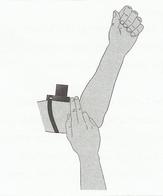 Shel Yad/Hand Tefillin The Tefillin Shel Yad is worn on the weaker arm, because there is a Limud from the posuk/verse in Parshas/(Torah portion) “Vehoyo Ki Yiviacho” which writes regarding the Shel yad that it is placed “al Yodchah”(on the arm) it is written with a seemingly extra letter hey after the chof , Chazal learn out from this “Yad Keho” which means “the weaker arm”. So for a right-handed person it is placed on the left arm and a left handed person wears the hand Tefillin on his right arm. Someone who is ambidextrous should wear it on his left arm. Someone who writes with one hand and all his other activities with the other should consult a Rav. The Titura of Bayis ( the base of the Tefillin) must rest on the center of the width of the biceps muscle and lean slightly toward the heart. The Shulchan Aruch and the Ramah hold that no part of it may rest and higher than the midpoint of the humerus bone -which is the bone that stretches from the shoulder to the elbow-. According to the Gra however it can go higher up, just no higher than the top edge of the biceps muscle. The lowest point that Titura may rest is on the lower edge of the biceps muscle, if it is any lower it is as if you are not wearing Tefillin. Now some hold that 1) this is determined when the arm is bent at an approximate 90 degree angle. 2) while others hold it is when the arm is outstretched and relaxed. You can determine its position by locating the base of the muscle with your finger and making sure that the front edge of the Titura is above it. As a general rule: If you can place your index and middle finger between the cleft of the arm and the front edge of the Titura when the arm is bent at an approximate ninety degree angle then it is most likely in the proper position according to the first opinion. And if you can place your pinky ring and middle fingers, then it is in the correct position according to the second opinion. As well the knot must be touching the Box the entire time you are wearing the Tefillin. Proper placement of Tefillin Shel Rosh The entire Bayis Shel Rosh(Head Tefillin) must rest above the original hairline which is determined by the hair roots of each individual person. If any part rests below, it is considered that the Tefillin are not being worn. Someone who’s hairline has receded should continue to place the entire Bayis shel rosh above his original hairline. If one looks closely at his forehead he can locate his original hairline as the part of the forehead where the hair once grew looks different then the rest of the forehead. In addition the Tefillin must be centered so that the middle of the bayis will rest directly above the bridge of the nose. The back edge of the bayis can reach until the top of the head, which is equivalent to the end of the soft spot on the baby’s head, this area can be identified by running the tip of ones finger straight upward from the front of the ear. Placement of the knot of the Shel RoshThe majority of the knot must rest on the center of the base of the skull, and the remainder of the knot may rest just below it in the indentation on the nape. Many people mistakenly think that the proper placement of the knot is completely in this indentation. If the knot is below the bone at the base of the skull then as long as the entire knot is above the hairline it is still acceptable. Tefillin straps tend to gradually stretch causing the bayis and knot of the Shel Rosh not to rest in their proper place, the straps of the Shel Rosh should be adjusted as necessary. |
Categories
All
AuthorRabbi Kass was ordained by Rabbi Yisrael Meir Lau, former Ashkenazik Chief Rabbi of Israel. He is certified as a Sofer for both Kesivah and Hagoah by one of the leading experts in Safrus, Rabbi Avrohom Tzvi Vosner, Rav of the Vad Mishmeres Sta”m. Archives
March 2018
|
What our clients say about us: |
To enhance our service quality, we operate on an appointment-only basis.
Please contact us to make an appointment. $12.99 Flat rate shipping! Mezuzahs, Tefillin & Accessories! |
|

